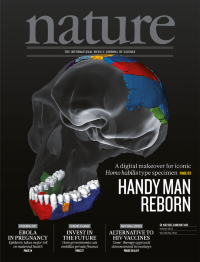Volume 519
-
No. 7544 26 March 2015
An artists impression of a galaxy with powerful large-scale outflows originating from its nuclear regions. Francesco Tombesi et al. report the detection of a powerful accretion-disk wind with a mildly relativistic velocity in the X-ray spectrum of IRAS F11119+3257, a nearby (z = 0.189) optically classified type 1 ultraluminous infrared galaxy hosting a powerful molecular outflow. The energetics of these winds are consistent with the suggestion that active galactic nuclei winds can provide an efficient way to transfer energy to the interstellar medium and support the theory that such winds affect the evolution of supermassive black holes and their host galaxies. Cover image: ESA/ATG medialab
Nature Outlook
-
No. 7543 19 March 2015
Genetic data have been used widely to inform our understanding of population history and migrations. Now with the advent of genome-wide analysis of single nucleotide polymorphism (SNP) data cataloguing variation between individuals at a single position in the genome sequence fine-scale genetic variation between human populations can be used as a signature of historical demographic events. Peter Donnelly and colleagues use such data from a selected geographically diverse sample of more than 2,000 individuals from the United Kingdom to reveal remarkable concordance between genetic clusters and geography. The results throw new light on several aspects of the peopling of Britain. For instance the genetic contribution to southeastern England from Anglo-Saxon migrations is under half, suggesting significant pre-Roman but post-Mesolithic population movement from the European continent. The data also reveal that non-Saxon regions contain genetically differentiated subgroups rather than a general Celtic population. Cover illustration: Jasiek Krzysztofiak/ Nature
-
No. 7542 12 March 2015
The idea that the Holocene is over and a new human-dominated geological epoch, the Anthropocene, has begun is being extensively discussed. As yet there is no formal agreement on when the Anthropocene may have started and defining the beginning of an epoch as a formal geologic unit of time requires locating a global marker of a shift in the Earths state recorded in stratigraphic material. Simon Lewis and Mark Maslin assess the anthropogenic signatures in the geological record against the formal requirements for the recognition of a new epoch and identify two dates � 1610 and 1964 � that may mark the beginning of the Anthropocene. See also the News Feature on page 144. Cover illustration: Alberto Seveso.
-
No. 7541 5 March 2015
A reconstructed Homo habilis skull based on the bones of the 1.8-million-year-old type specimen Olduvai Hominid 7 (OH 7) from Olduvai Gorge, Tanzania. Transparent parts are based on cranium KNM-ER 1813 from Kenya, morphed to fit OH 7. The species Homo habilis or handy man, was first described in the 4 April 1964 issue of Nature as the then earliest known member of the genus Homo. The challenge in the intervening years has been to work out which other fossils also belong to Homo habilis, a task complicated by the distortion of the OH 7 mandible which disguises its original shape. Now the mandible and vault bones of OH 7 have been subjected to state-of-the-art virtual reconstruction, using computed tomography and 3D imaging technology to realign the broken parts. The Homo habilis type emerges in a new light, combining a primitive jaw shape, resembling that of Australopithecus afarensis ('Lucy') with a brain as large as that of early Homo erectus. This new evidence indicates that multiple evolutionary lineages of the genus Homo existed well before 2 million years ago. Cover illustration: P. Gunz, S. Neubauer & F. Spoor




